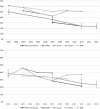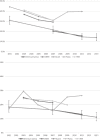Alcohol use in the Pacific region: Results from the STEPwise approach to surveillance, Global School-Based Student Health Survey and Youth Risk Behavior Surveillance System
- PMID: 26358376
- PMCID: PMC5049666
- DOI: 10.1111/dar.12328
Alcohol use in the Pacific region: Results from the STEPwise approach to surveillance, Global School-Based Student Health Survey and Youth Risk Behavior Surveillance System
Abstract
Introduction and aims: Alcohol use is a leading risk factor for disease and injury in Pacific Island countries and territories (PICT). This paper examines drinking patterns across 20 PICTs.
Design and methods: We synthesised published data from the STEPwise approach to surveillance or similar surveys for adults 25-64 years, and from the Global School-Based Student Health surveys and Youth Risk Behavior Surveillance System (YRBSS) for youth. We examined current and heavy drinking, and for adults also frequency of consumption. Using YRBSS, we studied trends in youth alcohol use in US-affiliated PICTs between 2001 and 2013.
Results: Alcohol consumption in adults and youth varied considerably across PICTs. In eight PICT populations, over 60% of male adults were current drinkers. Male adults consumed alcohol more frequently and engaged in heavy drinking more than female adults. Similar gender differences occurred in current and heavy drinking among youth. Across 10 PICTs, current drinking prevalence in males 13-15 years ranged from 10% to over 40%. Declines in alcohol use among grade 9-12 students were observed in YRBSS, although the magnitude differed by island and sex.
Discussion and conclusions: Alcohol consumption varies widely between PICTs. There are marked gender differences in use and abstention. There is scope in PICTs for implementation of best practice strategies to reduce alcohol-related harm. These need to be gender responsive and cognisant of concerning patterns of youth drinking. Strengthening surveillance of alcohol use and its consequences is vital to inform and monitor the impact of national and regional policies. [Kessaram T, McKenzie J, Girin N, Roth A, Vivili P, Williams G, Hoy D. Alcohol use in the Pacific region: Results from the STEPwise approach to surveillance, Global School-Based Student Health Survey and Youth Risk Behavior Surveillance System. Drug Alcohol Rev 2016;35:412-423].
Keywords: Pacific Islands; alcohol consumption; drinking behaviour; epidemiology; prevalence.
© 2015 The Authors. Drug and Alcohol Review published by Wiley Publishing Asia Pty Ltd on behalf of Australasian Professional Society on Alcohol and other Drugs.
Figures


Similar articles
-
Overweight, obesity, physical activity and sugar-sweetened beverage consumption in adolescents of Pacific islands: results from the Global School-Based Student Health Survey and the Youth Risk Behavior Surveillance System.BMC Obes. 2015 Sep 16;2:34. doi: 10.1186/s40608-015-0062-4. eCollection 2015. BMC Obes. 2015. PMID: 26401344 Free PMC article.
-
Youth risk behavior surveillance--Pacific Island United States Territories, 2007.MMWR Surveill Summ. 2008 Nov 21;57(12):28-56. MMWR Surveill Summ. 2008. PMID: 19023265
-
Youth Risk Behavior Surveillance - United States, 2015.MMWR Surveill Summ. 2016 Jun 10;65(6):1-174. doi: 10.15585/mmwr.ss6506a1. MMWR Surveill Summ. 2016. PMID: 27280474
-
Alcohol, cannabis and amphetamine-type stimulants use among young Pacific Islanders.Drug Alcohol Rev. 2011 Jan;30(1):104-10. doi: 10.1111/j.1465-3362.2010.00272.x. Drug Alcohol Rev. 2011. PMID: 21219505 Review.
-
Tobacco smoking prevalence in Pacific Island countries and territories: a review.N Z Med J. 2007 Oct 12;120(1263):U2742. N Z Med J. 2007. PMID: 17972962 Review.
Cited by
-
Poisoning deaths in China, 2006-2016.Bull World Health Organ. 2018 May 1;96(5):314-326A. doi: 10.2471/BLT.17.203943. Bull World Health Organ. 2018. PMID: 29875516 Free PMC article.
-
Determinants of alcohol consumption and marijuana use among young adults in the Republic of Palau.Environ Health Prev Med. 2021 Jan 22;26(1):12. doi: 10.1186/s12199-020-00928-8. Environ Health Prev Med. 2021. PMID: 33482714 Free PMC article.
-
Hepatocellular carcinoma in Pacific Islanders: comparison of Pacific Island-born vs. US-born.Hepatoma Res. 2023;9:7. doi: 10.20517/2394-5079.2022.85. Epub 2023 Mar 17. Hepatoma Res. 2023. PMID: 37035453 Free PMC article.
-
Assessing the progress on the implementation of policy and legislation actions to address the Non-Communicable Diseases crisis in the Pacific.PLoS One. 2022 Aug 11;17(8):e0272424. doi: 10.1371/journal.pone.0272424. eCollection 2022. PLoS One. 2022. PMID: 35951506 Free PMC article.
-
Concurrent Spinal Trauma in Patients with Traumatic Head Injury: A Seven-Year Retrospective Analysis.Med Sci Monit. 2023 Aug 19;29:e939215. doi: 10.12659/MSM.939215. Med Sci Monit. 2023. PMID: 37596775 Free PMC article.
References
-
- Secretariat of the Pacific Community . Déclaration de Tahiti Nui—Tahiti Nui Declaration (revised November 2011). Noumea, New Caledonia: Secretariat of the Pacific Community; 2012. Available at: http://www.spc.int/images/publications/ef/Corporate/ef‐tahiti‐nui‐declar... (accessed September 2014).
-
- Marshall M, Marshall LB. Holy and unholy spirits: the effects of missionization on alcohol use in Eastern Micronesia. J Pac Hist 1976;11:135–166.
-
- Secretariat of the Pacific Community and World Health Organization . Recommendations of the meeting on alcohol and health in the Pacific. September 28–30 2004, Noumea, New Caledonia. Available at: http://www.globalgapa.org/Regions/Western‐Pacific.aspx (accessed July 2014).
-
- Hoy D, Roth A, Viney K, et al Findings and implications of the Global Burden of Disease 2010 study for the Pacific Islands. Prev Chronic Dis 2014;11:130344. doi: http://dx.doi.org/10.5888/pcd11.130344. - DOI - PMC - PubMed
-
- Pacific Islands Forum Secretariat . Forty‐second pacific islands forum communique. September 7–8 2011, Auckland, New Zealand. Available at: http://www.forumsec.org/pages.cfm/newsroom/documents‐publications/forum‐... (accessed July 2014).
MeSH terms
LinkOut - more resources
Full Text Sources
Other Literature Sources
Medical

